La Crosse Technology WS-1610TWC-IT User Manual
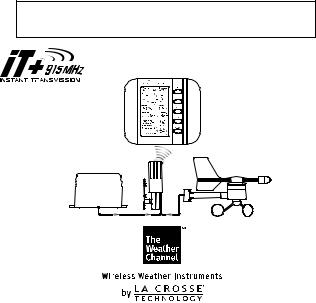
PROFESSIONAL WEATHER CENTER
WS-1610TWC-IT
Quick Set up Manual
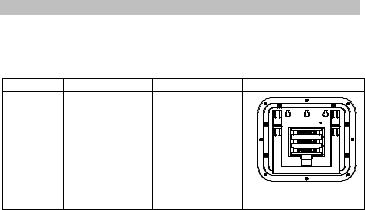
Quick Set Up Manual – Professional Weather Center
Using 915MHz wireless transmission of weather data, this unique weather station can be powered using batteries for all your weather needs in the home or office.
Carefully open and check that the following contents are complete:
Item: |
Consisting of: |
Fittings: |
Illustration: |
Base |
1) Main unit |
|
|
Station |
|
|
|
1

Thermo- |
1) |
Main unit |
1) |
Wall mounting |
|
|
|
|
|
|
|
|
|
|
|
|
|||||||
|
|
|
|
|
|
|
|
|
|
|
|||||||||||||
Hygro |
2) |
Rain |
|
screws |
|
|
|
|
|
|
|
|
|
|
|
|
|||||||
|
|||||||||||||||||||||||
Sensor |
|
protection |
2) |
Plastic |
|
|
|
|
|
|
|
|
|
|
|
|
|
|
|||||
|
|
cover |
|
anchors for |
|
|
|
|
|
|
|
|
|
|
|
|
|
|
|
|
|
|
|
|
|
|
|
|
|
|
|
|
|
|
|
|
|
|
|
|
|||||||
|
|
|
|
screws |
|
|
|
|
|
|
|
|
|
|
|
|
|
|
|||||
|
|
|
3) |
2 x cable ties |
|
|
|
|
|
|
|
|
|
|
|
|
|
|
|||||
|
|
|
|
|
|
|
|
|
|
|
|
|
|
|
|
||||||||
Wind |
1) |
Main unit with |
1) |
1 x U-bolts for |
|
||||||||||||||||||
Sensor |
|
wind vane |
|
mast holder |
|
||||||||||||||||||
|
2) |
32ft cable |
2) |
2 x Washers |
|
|
|
|
|
|
|
|
|
|
|
|
|
|
|
|
|||
|
|
(already |
3) |
2 x Nuts |
|
|
|
|
|
|
|
|
|
|
|
|
|
|
|
|
|||
|
|
4) |
2 x cable ties |
|
|
|
|
|
|
|
|
|
|
|
|
|
|
|
|
|
|
|
|
|
|
attached the |
|
|
|
|
|
|
|
|
|
|
|
|
|||||||||
|
|
main unit) |
|
|
|
|
|
|
|
|
|
|
|
|
|
|
|
|
|
|
|
|
|
|
|
|
|
|
|
|
|
|
|
|
|
|
|
|
|
|
|
|
|
|
|
|
|
|
3) |
Mast holder |
|
|
|
|
|
|
|
|
|
|
|
|
|
|
|
|
|
|
|
|
|
|
|
|
|
|
|
|
|
|
|
|
|
|
|
|
|
|
|
|
|
|
|
|
|
Rain |
1) |
Base and |
1) 2 x Screws |
|
|
|
|||||||||||||||||
Sensor |
|
funnel |
|
and Plastic |
|
||||||||||||||||||
|
2) |
32ft cable |
|
anchors |
|
||||||||||||||||||
|
|
(already |
|
|
|
|
|
|
|
|
|
|
|
|
|
|
|
|
|
|
|
|
|
|
|
attached the |
|
|
|
|
|
|
|
|
|
|
|
|
|
|
|
|
|
|
|
|
|
|
|
main unit) |
|
|
|
|
|
|
|
|
|
|
|
|
|
|
|
|
|
|
|
|
|
|
|
|
|
|
|
|
|
|
|
|
|
|
|
|
|
|
|
|
|
|
|
|
|
|
|
|
|
|
|
|
|
|
|
|
|
|
|
|
|
|
|
|
|
|
|
|
|
2
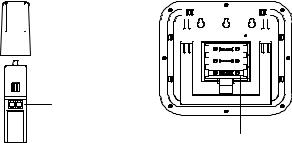
Setting Up:
Important: Operating power is supplied to both the wind and rain sensors by the thermo-hygro sensor
Thermo-Hygro Sensor |
Weather center |
||||||||||
|
|
|
|
|
|
|
|
|
|
|
|
|
|
|
|
|
|
|
|
|
|
|
|
|
|
|
|
|
|
|
|
|
|
|
|
|
|
|
|
|
|
|
|
|
|
|
|
|
|
|
|
|
|
|
|
|
|
|
|
|
|
|
|
|
|
|
|
|
|
|
|
|
|
|
|
|
|
|
|
|
|
|
|
|
|
|
|
|
|
|
|
|
|
|
|
|
|
|
|
|
|
|
|
|
|
|
|
|
|
|
|
|
|
|
|
|
|
|
|
|
|
|
|
|
|
|
|
|
|
|
|
Sockets for wind |
and rain sensor |
Battery compartment
Setting up using batteries:
1)Sensors: Pull and remove the protective rain cover of the Thermo-Hygro Sensor to reveal 2 socket ports and the battery cover. Insert the cables of the wind and rain sensors in the correctly marked sockets. Slide open the battery
3
compartment and checking the correct polarity insert 2 x AA IEC, LR6 1.5V batteries and replace the cover and rain cover
2)Base Station: Now open the battery cover at the back of the unit and checking the correct polarity insert 3 x AA IEC, LR6 1.5V batteries and replace the battery cover
Performing a function test and Setting time manually:
1.After powering up the units, the base station has to synchronize to the sensors before the weather data can be received.
2.Afterwards, the Weather Station will start receiving data from the transmitter. The outdoor temperature, humidity, windchill and wind speed should then be displayed on the Weather Station. If this does not happen after 30 seconds, the batteries will need to be removed from both units. You will have to start again from the beginning.
3.You may then check all cables for correct connection and all components for correct function by manually turning the wind-gauge, moving the weather-vane, tilting the rain sensor to hear the impact of the internally moving seesaw, etc.
4.Time and date shall be manually set.
5.After the Weather Station has been checked for correct function with regard to the above points and found fit, the initial set up of the weather station system is finished and the mounting of the system components can take place. It must be ensured however that all components work properly together at their chosen mounting or standing locations. If e.g. there appear to be problems with the 915 MHz radio transmission, they can mostly be overcome by slightly changing the mounting locations.
4
Note:
•Should any outdoor data not be received from the sensors (when “- - -“ is displayed), check all cables are correctly installed. Then user shall remove the batteries from all units and redo the set-up procedures after about 5 minutes.
•Wind speeds that read zero does not mean reception failure, it simply means that there was no wind at the time of reading the data.
Mounting the units:
Users must take their surroundings into consideration before deciding which method is best suited for them. Connection by cable is advantageous in that data from the sensors to the base station is interference free. Using 915MHz wireless transmission gives users little restriction on placement as that all units can be positioned virtually anywhere to within a 330 ft radius of the base station. You must decide which method is best suited to you. For cable connecting, please ensure that the cable included in this set meets with your distance requirements (see accessories in the main user manual for adding extension cables).
Important: Ensure all signals can be received and/or all cable distances meet with your requirements at the point of fixing particularly before you start drilling any mounting holes.
Wind sensor
Secure the main unit to the shaft of the mast holder using the single screw provided with the front of the sensor (marked E) facing in the East-West direction otherwise
5
wind direction will not be accurate. Now fix the entire unit to a suitable mast using the U-bolt, washers and nuts found in this set.
Note: For best results mount the wind sensor onto a mast to allow the wind to freely travel from all directions to enable an accurate reading (ideal mast size should be from Ø 5/8” to 11/4”). Ensure that the cable of the wind sensor meets your distance requirements
Rain sensor
The rain sensor should be mounted horizontally about 2-3ft off from the ground in an open area away from trees or other coverings to allow rain to fall naturally for an accurate reading.
Note: For best results ensure the base is horizontal to allow maximum drainage of any collected rain
Thermo-hygro Sensor
To wall mount the thermo-hygro sensor, fix the wall holder onto the desired wall (2 screws are supplied), plug the sensor firmly into the wall holder and then carefully replace the rain cover back over the thermo-hygro sensor.
Note: After mounting the units, should the weather data not be received, user may need to remove the batteries from all units and redo the set-up procedures after about 5 minutes.
6
WARRANTY
For warranty work, technical support, or information contact:
La Crosse Technology, Ltd |
Springfield / Lacrosse Canada. |
2809 Losey Blvd. South |
1-800-661-6721 |
La Crosse, WI 54601 |
5151 Thimens Rd. |
Phone: 608.782.1610 |
Montreal, Quebec |
Fax: 608.796.1020 |
H4R 2C8 |
e-mail: support@lacrossetechnology.com (warranty work)
sales@lacrossetechnology.com (information on other products)
web: www.lacrossetechnology.com
For more information, please visit: www.lacrossetechnology.com/1610itc
All rights reserved. This handbook must not be reproduced in any form, even in excerpts, or duplicated or processed using electronic, mechanical or chemical procedures without written permission of the publisher.
7
This handbook may contain mistakes and printing errors. The information in this handbook is regularly checked and corrections made in the next issue. We accept no liability for technical mistakes or printing errors, or their consequences.
All trademarks and patents are acknowledged.
8
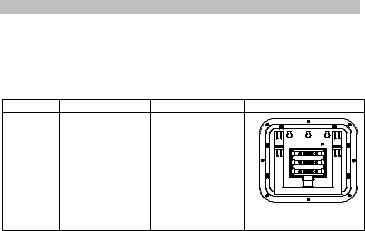
Montage rapide – Centre Météo Professionnel
Ce poste météo unique, qui utilise la transmission sans fil 915MHz des données météo, peut être alimenté par piles pour remplir tous vos besoins chez vous ou au bureau.
Ouvrir et vérifier soigneusement que l’ensemble comprend toutes les parties suivantes:
Article: |
Consiste en: |
Accessoires: |
Illustration: |
Poste de |
1) Appareil |
|
|
base |
principal |
|
|
9

Capteur |
1) |
Appareil |
1) |
Vis |
|
|||||||||||||||||||
thermo- |
|
principal |
|
d’installation |
|
|
|
|
|
|
|
|
||||||||||||
hygro |
2) |
Capuchon |
|
murale |
|
|
|
|
|
|
|
|
|
|||||||||||
|
|
anti-pluie |
2) |
Chevilles en |
|
|
|
|
|
|
|
|
|
|||||||||||
|
|
|
|
|
|
|
|
|
|
|||||||||||||||
|
|
|
|
|
|
|
|
|
|
|
||||||||||||||
|
|
|
|
plastique pour |
|
|
|
|
|
|
|
|
|
|
|
|||||||||
|
|
|
|
les vis |
|
|
|
|
|
|
|
|
|
|
|
|||||||||
|
|
|
|
|
|
|
|
|
|
|
|
|
|
|||||||||||
|
|
|
3) |
2 x frettes de |
|
|
|
|
|
|
|
|
|
|||||||||||
|
|
|
|
câblage |
|
|||||||||||||||||||
Capteur |
1) |
Appareil |
1) |
1 x Boulons en |
|
|||||||||||||||||||
vent |
|
principal avec |
|
U pour support |
|
|||||||||||||||||||
|
|
girouette |
|
poteau |
|
|
|
|
|
|
|
|
|
|
|
|
|
|
|
|
|
|||
|
2) |
Câble de 32 ft |
2) |
2 x Rondelles |
|
|
|
|
|
|
|
|
|
|
|
|
|
|
|
|
|
|||
|
|
|
|
|
|
|
|
|
|
|
|
|
|
|
|
|
|
|
|
|||||
|
|
(déjà fixé à |
3) |
2 x Boulons |
|
|
|
|
|
|
|
|
|
|
|
|
|
|
|
|
|
|
|
|
|
|
|
|
|
|
|
|
|
|
|
||||||||||||||
|
|
|
|
|
|
|
|
|||||||||||||||||
|
|
l’appareil |
4) |
2 x frettes de |
|
|||||||||||||||||||
|
|
principal) |
|
câblage |
|
|||||||||||||||||||
|
3) |
Support |
|
|
|
|
|
|
|
|
|
|
|
|
|
|
|
|
|
|
|
|
|
|
|
|
poteau |
|
|
|
|
|
|
|
|
|
|
|
|
|
|
|
|
|
|
|
|
|
|
Capteur |
1) |
Base et |
1) |
2 x Vis et |
|
|
|
|||||||||||||||||
pluie |
|
entonnoir |
|
chevilles |
|
|||||||||||||||||||
|
2) |
Câble de 32ft |
|
|
|
|
|
|
|
|
|
|
|
|
|
|
|
|
|
|
|
|
|
|
|
|
(déjà fixé à |
|
|
|
|
|
|
|
|
|
|
|
|
|
|
|
|
|
|
|
|
|
|
|
|
l’appareil |
|
|
|
|
|
|
|
|
|
|
|
|
|
|
|
|
|
|
|
|
|
|
|
|
principal) |
|
|
|
|
|
|
|
|
|
|
|
|
|
|
|
|
|
|
|
|
|
|
|
|
|
|
|
|
|
|
|
|
|
|
|
|
|
|
|
|
|
|
|
|
|
|
|
|
|
|
|
|
|
|
|
|
|
|
|
|
|
|
|
|
|
|
|
|
|
|
|
|
10
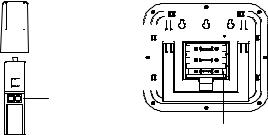
Montage:
Important: Les capteurs vent et pluie sont alimentés par le capteur thermo-hygro.
Capteur thermo-hygro |
|
Poste de base |
||||||||||||
|
|
|
|
|
|
|
|
|
|
|
|
|
|
|
|
|
|
|
|
|
|
|
|
|
|
|
|
|
|
|
|
|
|
|
|
|
|
|
|
|
|
|
|
|
|
|
|
|
|
|
|
|
|
|
|
|
|
|
|
|
|
|
|
|
|
|
|
|
|
|
|
|
|
|
|
|
|
|
|
|
|
|
|
|
|
|
|
|
|
|
|
|
|
|
|
|
|
|
|
|
|
|
|
|
|
|
|
|
|
|
|
|
|
|
|
|
|
|
|
|
|
|
|
|
|
|
|
|
|
|
|
|
|
|
|
|
|
|
|
|
|
|
|
|
|
|
|
|
|
|
|
|
|
|
|
|
|
|
|
|
|
|
|
|
|
|
|
|
|
|
|
|
|
|
|
|
|
|
|
|
|
|
|
|
|
|
|
|
|
|
|
|
|
|
|
|
|
|
|
|
|
|
|
|
|
|
|
|
|
|
|
|
|
|
|
|
|
|
|
|
|
|
|
|
|
|
|
|
|
|
|
|
|
|
|
|
|
|
|
Prises pour |
|
capteur vent et |
|
pluie |
Logement des piles |
|
Montage avec les piles:
1)Capteurs: Tirer et enlever le capuchon anti-pluie du capteur thermohygro pour révéler deux prises et le couvercle des piles. Insérer les câbles des capteurs vent et pluie dans les prises conformément aux
11
indications. Ouvrir le couvercle du logement en le faisant coulisser et installer 2 piles AA/R6 1,5V en respectant les polarités. Remettre le couvercle en place.
2)Poste de base: Ensuite ouvrir le couvercle des piles au dos de l’appareil et installer 3 piles AA/R6 1,5V en respectant les polarités. Remettre le couvercle en place.
Effectuer un test et règler l’heure manuellement:
1.Après que les piles sont en place dans les appareils, le poste de base doit synchroniser les capteurs avant de recevoir les données météo.
2.Ensuite, le poste météo commence à recevoir les données de l’émetteur. La température extérieure, l’humidité, le facteur vent et la vitesse du vent devraient s’afficher sur le poste météo. S’ils ne s’affichent pas dans les 30 secondes, retirer les piles des deux appareils et recommencer à partir du début.
3.Il est conseillé de vérifier la bonne connexion de tous les câbles et de s’assurer que tous les éléments fonctionnent correctement : tourner manuellement la jauge vent, bouger la girouette, incliner le capteur pluie pour entendre le balancier interne, etc.
4.Règler manuellement l’heure et la date.
5.Quand on s’est assuré que le poste météo fonctionne correctement en ce qui concerne les points ci-dessus, le montage initial est terminé et il est possible de mettre les différents éléments du système en place. Cependant, il faut s’assurer que tous les éléments fonctionnenrt correctement aux lieux dans lesquels ils doivent être installés. Par exemple, si des problèmes de transmission radio 915
12
MHz apparaissent, il est souvent facile de les règler en changeant légèrement les appareils de place.
Note:
•En cas de non-réception des données extérieures des capteurs (quand “- - -
“ s’affiche), vérifier que tous les câbles sont installés correctement. Ensuite, retirer les piles de tous les appareils et recommencer la procédure de montage 5 minutes plus tard.
•Une vitesse de vent affichant zéro n’indique pas une mauvaise réception. Ceci indique simplement qu’il n’y a pas de vent au moment de la lecture des données.
Mise en place des appareils:
Prendre l’environnement en considération avant de décider quelle méthode convient le mieux . La connexion par câble est avantageuse en ce sens que les données sont transmises des capteurs au poste de base sans aucune interférence. L’uilisation de la transmission sans fil 915MHz permet de placer les appareils pratiquement n’importe où dans un rayon de 330ft (110m) du poste de base. C’est à l’utilisateur de décider quelle méthode lui convient le mieux. Pour la connexion par câble, s’assurer que le câble de 10 m inclus avec l’appareil convient à la distance prévue (se reporter aux accessoires dans le mode d’emploi principal pour ajouter des prolongateurs).
Important: S’assurer de la bonne réception de tous les signaux et/ou que la distance câblée est adéquate avant de percer des trous pour fixer les appareils en place.
13
Capteur vent
Fixer l’appareil principal à la tige du support de poteau à l’aide de la vis fournie sur le devant du capteur (marqué E) en l’installant face à la direction Est-Ouest, sinon la direction du vent ne sera pas précise. Fixer ensuite tout l’appareil sur un poteau adéquat à l’aide du boulon en U, des rondelles et des boulons fournis avec l’appareil.
Note: Pour de meilleurs résultats, fixer le capteur vent sur un poteau pour permettre au vent de circuler librement de toutes les directions et permettre des relevés précis (la taille idéale du poteau est entre Ø 5/8” (16 mm) et 11/4” (33 mm)). S’assurer que le câble du capteur vent est d’une longueur adéquate.
Capteur pluie
Le capteur pluie devrait être installé horizontalement à 2-3ft (60-90cm) du sol dans un lieu dégagé à l’écart des arbres ou autres couvertures pour permettre à la pluie de tomber naturellement et obtenir des relevés précis.
Note: Pour de meilleurs résultats, s’assurer que la base est horizontale pour permettre un écoulement maximum de la pluie collectée.
Capteur thermo-hygro
Pour fixer le capteur thermo-hygro sur un mur, fixer le support mural à l’endroit désiré (2 vis sont fournies); connecter solidement le capteur au support mural et remettre soigneusement le capuchon en place sur le capteur thermo-hygro.
14
Note: En cas de non-réception des données après que les appareils ont été mis en place, retirer les piles de tous les appareils et recommencer la procédure de montage après 5 minutes environ.
GARANTIE
Pour toute intervention sous garantie, support technique ou information, veuillez contacter
La Crosse Technology, Ltd |
Springfield / Lacrosse Canada. |
2809 Losey Blvd. South |
1-800-661-6721 |
La Crosse, WI 54601 |
5151 Thimens Rd. |
Phone: 608.782.1610 |
Montreal, Quebec |
Fax: 608.796.1020 |
H4R 2C8 |
e-mail : support@lacrossetechnology.com (interventions sous garantie)
sales@lacrossetechnology.com (informations sur les autres produits)
site web : www.lacrossetechnology.com
Pour d'ample informations, visiter: www.lacrossetechnology.com/1610itc
15
Tous droits réservés. Ce manuel ne peut être ni reproduit sous quelque forme que ce soit, même sous forme d'extraits, ni copié, ni traité par procédure électronique, mécanique ou chimique, sans l'accord écrit de l'éditeur.
Ce manuel peut contenir des erreurs et fautes d'impression. Les informations contenues dans ce manuel sont régulièrement vérifiées, les corrections étant apportées à l'édition suivante. Nous n'acceptons aucune responsabilité pour les erreurs techniques ou d'impression ou pour leurs conséquences.
Toutes les marques commerciales et brevets sont reconnus.
EJMA1610L220
16
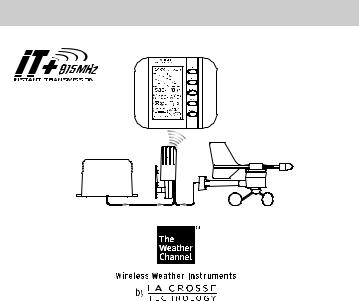
PROFESSIONAL WEATHER CENTER
WS-1610TWC-IT
Operation Manual
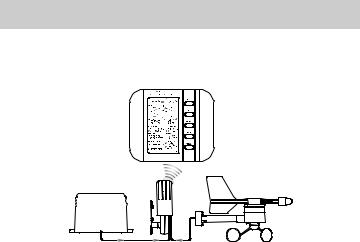
PROFESSIONAL WEATHER CENTER
WS-1610TWC-IT
Operation Manual
Table of Contents
Topic |
Page |
|
|
Features |
3 |
|
|
Setting up |
6 |
|
|
Function keys |
12 |
|
|
LCD Screen |
14 |
|
|
Manual Setting |
16 |
|
|
Time alarm setting |
24 |
|
|
Weather alarm operations |
25 |
|
|
Hysteresis |
31 |
|
|
Weather forecast and weather tendency |
32 |
|
|
Wind direction and wind speed measurement |
36 |
|
|
Rainfall measurement |
37 |
|
|
Viewing history data |
37 |
|
|
Viewing the min/ max weather data |
39 |
|
|
Switch On/ Off buzzer |
46 |
|
|
Outdoor transmission 915 MHz reception |
48 |
|
|
Positioning |
49 |
|
|
Care and Maintenance |
53 |
|
|
Specification |
54 |
|
|
Warranty Info |
56 |
|
|
1
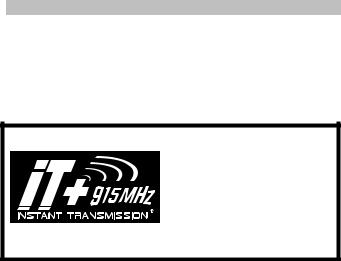
PROFESSIONAL WEATHER CENTER
Instruction Manual
Congratulations on purchasing this state-of-the-art Professional Weather Center as an example of excellent design and innovative technology. Featuring time, date, calendar, weather forecast, wind direction and speed, rainfall, outdoor temperature and outdoor humidity, air pressure and various alarm settings for different weather conditions, this Weather Center will provide you with extensive weather information and forecast.
This product offers:
INSTANT TRANSMISSION is the state-of-the-art new wireless transmission technology, exclusively designed and developed by LA CROSSE TECHNOLOGY. INSTANT TRANSMISSION offers you an immediate update (every 4 seconds!) of all your outdoor data measured from the transmitters: follow your climatic variations in real-time!
2
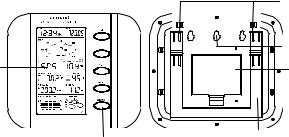
FEATURES:
Weather Center |
|
Foldout stand I |
|
|
|
|
|
|
|
|
|
Hanging hole |
LCD |
Battery compartment |
|
|
|
cover |
Foldout stand II
Function keys
•Time display (manual setting)
•12/24 hour time display
•Calendar display (weekday, date, month, year)
•Time alarm function
•Weather forecasting function with 3 weather icons and weather tendency indicator
•Outdoor temperature display in ºF/°C
•Outdoor Humidity display as RH%
•MIN/MAX value of outdoor temperature and humidity display with time & date of recording
3

•Low/High outdoor temperature and humidity alarm
•Relative air pressure displayed in inHg or hPa
•Air pressure tendency indicator for the past 12 hours (bargraph format)
•LCD contrast selectable
•Low battery indicator
•Wind direction displayed in 16 steps
•Wind speed displayed in mph, km/h, or m/s, and Beaufort scale
•Wind chill displayed in °F of °C
•Max wind speed displayed with time & date of recording
•High alarm function for wind speed
•Manual reset of outdoor temperature/ humidity, pressure and wind chill data
•Total rainfall displayed in mm or inch
•Storm warning alarm
•Buzzer on/off selectable
•Storage of 200 sets of history weather data recorded in 3-hour intervals
•Wireless transmission at 915 MHz
•Transmission range up to 330 feet (100 meters)
Thermo-hygro Sensor
•Remote transmission of the outdoor temperature and humidity to the Weather Center at 915 MHz
•Weather-resistant casing
•Wall mounting case (to be mounted in a sheltered place. Avoid
direct rain and sunshine)
4
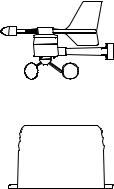
Wind Sensor
• Connected to the thermo-hygro sensor by cable
•Can be installed onto a mast or a horizontal panel
Rain Sensor
•Connected to the thermo-hygro sensor by cable
• To be mounted onto a horizontal panel
5
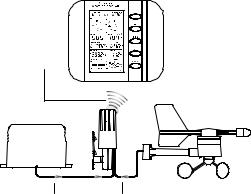
SETTING UP:
Wireless transmission at 915 MHz - thermo-hygro sensor to the Weather Center
Weather Center
Rain sensor
Wind sensor
Cable connection between the rain sensor and the thermo-hygro sensor
Cable connection between the wind sensor and the thermo-hygro sensor
Note:
When putting the Weather Center into operation, it is important to perform in close proximity (e.g. on a table) a complete wiring and set-up of the system. This step is
6

important to test all components for correct function before placing and mounting them at their final destinations (See Positioning below)
1.Unwind the cables of the Rain and the Wind sensors. Connect the Rain and the Wind sensors to the Thermo-hygro sensor by plugging the connector heads of the two sensors into the appropriate sockets of the Thermo-hygro sensor.
Sockets for wind |
and rain sensor |
2.First insert the batteries into the Thermo-hygro sensor (see “How to install and replace the batteries into the Thermo-hygro sensor“ below).
3.Then insert the batteries into the Weather Center (see “How to install and replace the batteries into the Weather Center” below). Once the batteries are installed, all segments of the LCD will light up briefly and a short signal tone will be heard. It will then display the time as 12:00, the date as 1.1.05, the weather icons, and air pressure value. "- - -" will be shown for outdoor data.
4.Afterwards, the Weather Center will start receiving data from the transmitter. The outdoor temperature, humidity wind chill and wind speed should then be
7
displayed on the Weather Center. If this does not happen after 30 seconds, the batteries will need to be removed from both units. You will have to start again from step 1.
5.You may then check all cables for correct connection and all components for correct function by manually turning the wind-gauge, moving the weather-vane, tilting the rain sensor to hear the impact of the internally moving seesaw, etc (See Positioning below).
6.Time and date shall be manually set (See Manual Setting below).
7.After the Weather Center has been checked for correct function with regard to the above points and found fit, the initial set up of the weather station system is finished and the mounting of the system components can take place. It must be ensured however that all components work properly together at their chosen mounting or standing locations. If e.g. there appear to be problems with the 915 MHz radio transmission, they can mostly be overcome by slightly changing the mounting locations.
Note:
The radio communication between the receiver and the transmitter in the open field reaches distances of max 330 feet, provided there are no interfering obstacles such as buildings, trees, vehicles, high voltage lines, etc.
8.Radio interferences created by PC screens, radios or TV sets can in some cases entirely cut off radio communication. Please take this into consideration when choosing standing or mounting locations.
8

Note :
•After batteries are installed in the transmitter, install the batteries in the weather center to receive the signal from the transmitter as soon as possible. If the weather center is powered more than 5 hours after the transmitter is powered, the weather center will never receive signal successfully from this transmitter. In this case, user will need to reinstall the batteries from the transmitter to redo set-up procedure.
•After batteries are installed, there will be synchronization between weather center and the transmitter. At this time, the signal reception icon will be blinking. When the signal is successfully received by the weather center, the icon will be switched on. (If it is not successful, the icon will not be shown in LCD) So the user can easily see whether the last reception was successful (icon on) or not (icon off). On the other hand, the short blinking of the icon shows that a reception is in progress.
 Transmitter signal reception icon
Transmitter signal reception icon
•If the signal reception is not successful on the first frequency (915MHz) for 14 seconds, the frequency is changed to 920MHz and the learning is tried another
9

14 seconds. If still not successful the reception is tried for 14 seconds on 910MHz. This will also be done for re-synchronization.
HOW TO INSTALL AND REPLACE THE BATTERIES INTO THE WEATHER CENTER
The Weather Center works with 3 x AA, IEC LR6, 1.5V batteries. When the batteries need to be replaced, the low battery symbol will appear on the LCD.
To install and replace the batteries, please follow the steps below:
1.Remove the battery compartment
cover.
2. Insert the batteries observing the correct polarity (see the marking in the battery compartment).
3. Replace the battery cover.
HOW TO INSTALL AND REPLACE THE BATTERIES INTO THE THERMO-HYGRO SENSOR
The outdoor Thermo-hygro sensor works with 2 x “AA”, IEC LR6 1.5V batteries. To install and replace the batteries, please follow the steps below:
10

1.Uninstall the rain cover of the transmitter.
2.Remover the battery compartment cover.
3.Insert the batteries, observing the correct polarity (see the marking in the battery compartment).
4.Replace the battery cover and the rain cover onto the
unit.
Note:
In the event of changing batteries in any of the units, all units need to be reset by following the setting up procedures. This is because a random security code is assigned by the thermo-hygro sensor at start-up and this code must be received and stored by the Weather Center in the first 30 seconds of power being supplied to it.
BATTERY CHANGE:
It is recommended to replace the batteries in all units every 24 months to ensure optimum accuracy of these units.
Please participate in the preservation of the environment. Return used batteries to an authorized depot.
11
